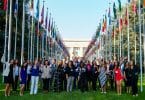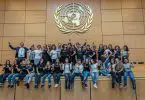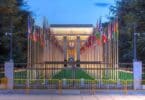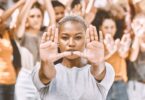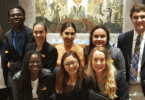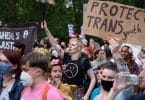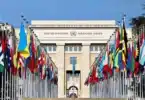Human Flow (2017)
Human Flow was the “movie of the refugee crisis” as critics often called it. Let me put it like this, you have a friend or a family member who often hears about refugees in the world, sees a diverse community or newly-resettled refugees in your community or neighborhood but who has never understood why people from other countries are welcomed in other places around the world, this is the movie to play on a movie night with him/her.
If one has time only for one movie to watch about refugees, Human Flow is your go-to choice.
It is the fruit of big efforts of the Chinese contemporary artist and activist Ai Wei Wei who, through this great work, aims at showing to different audiences the root causes behind displacement of people all over the world. He travelled through 23 countries in different continents to visually capture the reality of the “refugee crisis” in today’s world and bring it to the audience in a very captivating format and in simple words and visuals to explain the phenomenon of displacement to all people. The documentary focuses on different regions and countries, especially those which have been notably affected by the biggest numbers of refugee arrivals such as Greece, Turkey, France, Germany, Jordan, Kenya, Iraq…
Human Flow is not a fictional movie, which means there is no particular story or protagonist that the audience follows from start to end. It is more like a documentary which follows the migratory situation in different countries around the world.
One more thing to highlight about this movie is definitely the production quality. Having a full high quality drone scenery of the biggest refugee camps in the world gives you the impression that you are physically present in the field, especially if you watch it on a big screen, like I did when it was premiered in Brussels in February 2018. I could not wait for it to be available locally, and I was lucky to find cheap flights to Brussels during that week. So, I did not hesitate one moment to book my trip. I had no idea what else I would do for the rest of my time in Brussels, or which friends I would meet, but all I knew was that I wanted to watch Human Flow; everything else would come later.
It was a very emotional experience, especially that I was there on the Greek Island of Lesvos when Ai Wei Wei was filming the documentary. Watching those beautiful scenes in places I knew very well and seeing few familiar faces on the screen made me relive beautiful moments I spent in Lesvos with very brave refugees.
Register now: International Migrations (Free online course)
First They Killed My Father (2017)
Inspired by a book with the same title, written by activist Loung Ung, the movie tackles the issue of forced displacement, child encampment and Internally Displaced People (IDPs). Realized and directed by Angelina Jolie, UNHCR Special Envoy, the movie is a biographical historical thriller of Cambodian activist Loung Ung who was forced to be a child soldier since the early age of 5 during the Communist Khmer Regime.
I must say that parts of the movie are hard to watch, especially if you have not read about child soldiers and mistreatment of children in wartime previously. With my professional focus on child protection, it was quite frustrating to follow scenes of torture and mistreatment inside labor camps in Cambodia, knowing that these incidents are still happening every day in countries like Eritrea, and that the people I work with today in the camps have either been through the exact same atrocities or have fled their countries to avoid them.
This 1975 thriller depicts the problem of forced internal displacement as families are forced out of their homes and villages by the Regime and pushed away into camps where they undergo forced labor, starvation, mistreatment, confiscation of belongings, deprivation of healthcare and foreign medicine and the list goes on. It also deals with the pertinent issue of children’s human rights in wartime and conflict zones, by illustrating the life of child soldiers, children IDPs and depicting children’s life-saving journey fleeing their homes for a better future.
Register now: Harvard launches free online course on Children’s Human Rights!
Beasts of No Nation (2015)
Again on the issue of child protection, child refugees and IDPs, Beasts of No Nation is an internationally renown movie that has recently been added on Netflix and that everyone working on the issue of refugees should watch. There are usually a lot of movies on wartime, and a lot of movies on children. However, it is rather rare to find movies tackling the issue of children actively yet forcibly participating in war. In this context, Beasts of No Nation follows the story of Agu, a Nigerian child living in the “buffer zones” which are areas protected by the United Nations from the internal conflict in the country. But this temporary security soon comes to an end when his area gets invaded by the local government, killing families, bombing huts and kidnapping children to be forcibly taken to military training camps. He ends up being part of a whole child army run by The Commandant, played by Idris Alba. It illustrates the gradual yet fast transition from an innocent playful child to a perpetrator of the war, highlighting the trauma of forced displacement, forced labor and war on the psychology of children.
It is crucial to watch Beasts of No Nation for those who work with African refugees and asylum seekers, especially with children, and who might encounter similar stories to Agu’s. The movie would serve not only as an eye-opener to what is happening in civil wars in Africa but also as a very accurate Country of Origin Information resource for people involved in Refugee Status Determination procedures.
Register now: Child Protection in Humanitarian Settings (Columbia University)
Born in Syria (2016)
Following the stories of 7 Syrian refugee children in Europe, Born in Syria is one of the rare movies that focus on the whole journey of refugees from home country to local integration in the host country. It follows children by depicting their life in Syria before, during and after the conflict, thus highlighting the traumatizing experiences they have been through in detail. It follows their journey in reception centers and refugee camps in Turkey, Hungary and Greece and what that resulted in later on in their life. And finally, it follows up on their integration in their final destination in Europe during their first 6 months in the country. Through this last stage, you can see the different ways of acculturation that newly-arrived refugees usually adopt, which often differ even within the same family. You follow their asylum procedures from the first reception center until the happy and very emotional moments of receiving the refugee status, and you continue to see the transitions in people’s lives, especially children’s lives through the efforts made to integrate into a new country, including language learning, communicating with the local community and starting a new school for the first time in years.
Refugee (2016)
Refugee is a filmmaker project realized by 5 renowned photographers including Clementine Malpas and Leslie Knott. The photographers travelled the world to illustrate the atrocities of war, political persecution and other root causes of refugee displacement. The very first scene of the movie actually starts with the refugee definition in the 1951 Geneva Convention, which I thought was very clever as it caters for all kinds of audiences. It also sheds light on the issue of family reunification of refugees in Europe and the effects family separation has on displaced communities in different places. It is not the easiest watch, or the kind of movie you would play after a bad day at work, as it depicts the issue of migration from a very realistic perspective; but it is a must watch if you want to know more about refugees.
Register now: Human Rights – The Rights of Refugees (Free course by Amnesty International)

